View current page
...more recent posts
More dubious fractal analysis of Pollocks and digs at that goldang modern art from Randy Kennedy of teh NY Times.
two researchers conclude that Dr. Taylorís analysis of Pollock paintings is flawed because it did not use a great enough range of box sizes to establish fractal characteristics reliably. Using only the range he did, a childlike drawing like the one made by Ms. Smith-Jones turned out to be, mathematically at least, the equal of a Pollock ó a notion that would undoubtedly amuse critics who still dismiss his work as childís play.Since when is Rush Limbaugh's opinion relevant?
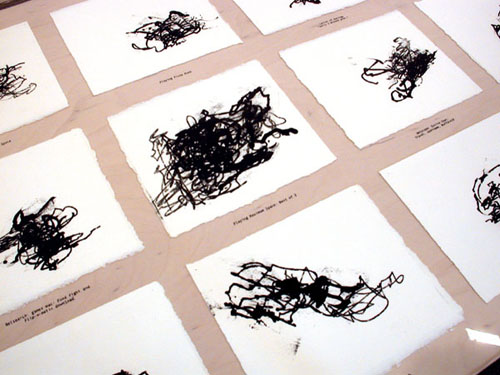
A previous post dealt with several incarnations of the "mousepad drawing"--by Kristin Lucas (1999--photo above), the Eyebeam Open Lab (2006), and Joseph DeLappe (1999-2002). To recap, Lucas inked a mouseball and let it make drawings while she played games, answered email, etc.; the Eyebeam project is a recently-invented "double mouse" that allows anyone to make abstract marks on one screen while doing routine things on another; and the DeLappe is a mouse with various physical pencil and brush extensions that also make mock-gestural drawings. I can't really compare the drawings because I've only seen the Lucas firsthand (they were nice, with an organic Cy Twombly-ish feel belied by the banal origins). However, I'm intrigued by her expressed intentions behind the work in a way I'm not with the other projects. The presence or absence of an underlying rationale goes a long way towards defining whether something is art in the humanist, Western Civ tradition or just an extension of tech practice. Here's what Lucas says about her series:
"At the time, I was making work about the influence of programmed environments on my behaviorial patterns (mental and physical). So [in the case of the mousepad drawings] an influence of the virtual recorded in the physical realm. I found the inked mouse drawings looked psychological--their motion cramped, frustrated, oscillating between resisting control by external forces and controlling oneself (like being trapped in an argument with oneself). My drawings are never shown with the tool so they are more about the discovery of what they are and enjoying the irony or sincerity of what the task was. Also factoring in was the scale of a world wide experience reduced to a tiny sheet of paper.By contrast, DeLappe (photos immediately below) seems to be making a broad critique of the pseudoscientific forebears (or cousins) of modern art such as graphology, Freudian analysis, and/or mediumistic "automatic writing" (one supposes--the statements I found on his website don't really explain why he is doing it) by presenting entire suites of work each of which is supposedly influenced by a specific activity such as preparing income taxes, or surfing Museum websites. These sources of anti-inspiration or non-inspiration are exhaustively detailed in the finished display, down to noting the URLs and characteristic colors of art world sites. Unlike Lucas, he presents the mouse as a sculptural object related to the drawings and even lists the brand of the mouse in the description.
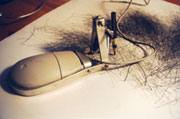
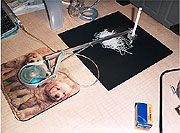
By the time we get to the Eyebeam Open Lab's "9 to 5 Paintings," the idea has been mainstreamed and popularized down to the level of an executive toy, with breezy description to match:
Create art while you work! If you find yourself spending more and more time answering email, and less and less time making art then why not do them both at the same time? Turn your emails, internet browsing, and report writing into digital paintings. 9 to 5 paintings are a visual representation of your daily computing routines.
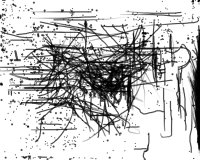
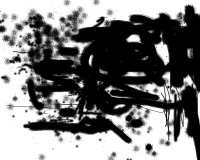
Here it's mainly about the gear, and BAW (bored at work) fun. The introspection and societal critique of Lucas' project has been decanted away, leaving only the absurdity.
Related: techy takes on Pollock.
"ElectroYacht" [mp3 removed]
Digital percussion kit crafted with a Sherman filterbank (originally by Speedy J with some changes by me), with an analog break (played twice) on the Mutated Sidstation--a kind of tuned drum setting played at different pitches using midi cc (continuous controller) messages. Unlike the previous track, which I spent way more time on, this has a nice relaxed vibe.
"Ionic Baroque" [mp3 removed]
In this song I've grafted together layered nasal synthesizer melodies with orchestral instruments such as strings, marimba and tympani. I had the idea to do, as I described to someone in an email, "baroque chamber music using dismantled electronic dance elements." This is a stab at that. The piece is tightly organized at the beginning, breaks down about 2/3 of the way through, and never completely recovers--that is deliberate.
Just realized I started posting music on my "mostly music" blog two years ago this month (and cross-posted most of it here). Unbelievable--time flies, etc.
Update: am working on a longer, "dance" version of this tune. Instead of the "breakdown" described above, a house thump fades up and rescues the momentum of the song, carrying it well beyond the current end. With the four-on-the-floor rhythm underneath, the strings have a "hooked on classics" feel.
And here it is:
"Ionic Baroque (Dance Mix)" [mp3 removed]
Excellent '70s strangeness: two songs by the Boston-based Orchestra Luna, who released one record of eccentric showtune-influenced music on Epic and then were dropped by the label. Produced by Rupert Holmes of "Pina Colada" fame, and it shows. Nevertheless, it's not a big stretch from this music to the Bonzo Dog Band or Slapp Happy. I thought I was a cult of one; thank god for the internet. The sound files below are from the website of Rick Berlin, who recorded under his given name Rick Kinscherf on the Orchestra Luna LP.
"Boy Scout Camp" [2.8 MB .mp3]
"Little Sam" [3.8 .mp3]
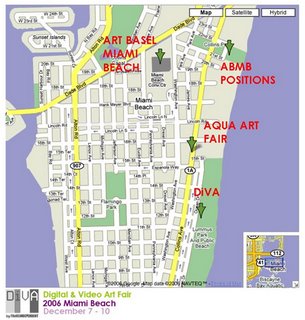
I'm happy to announce that my DVDs and works on paper will be in Miami this year--artMovingProjects is showing them at DiVa Miami, the Digital and Video Art Fair, which will have "white cube" spaces set up in shipping containers on the beach. A page for my work is here. Other artists represented include Jillian Mcdonald, Marcin Ramocki, Linda Post and Adam Simon.
Ramocki, who also directed the movie 8 BIT, will be attending with the film's producer and co-director Justin Strawhand. He reports, over on the vertexList blog:
8 BIT is going to open the party; presented by artMoving and KBP, we will be screening at Hotel Victor, Ocean Drive between 11th and 12th street - South Beach, Miami Beach, 12/08/2006, 7 00 pm - 8 30 pm. You can get the tickets for the event here. Both Justin and I will be there to answer questions and have some tropical drinks.Ramocki adds:
For those trying to catch 8 BIT here in NYC, I am proud to announce we will be a part of the historic Blip Festival 2006! Our screening is on Saturday, Dec 02, 2 pm - check it out!
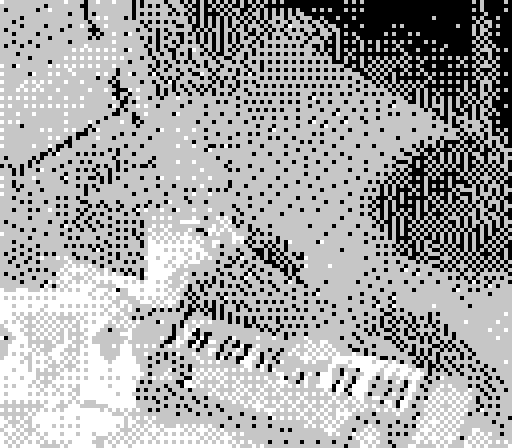
"ally3" - GIF artist unknown - enlarged - 188KB
Anxiety of Influence
1999
Kristin Lucas, mousepad drawings.
Lucas inked a mouseball and let it make gestural drawings while she played games, answered email, etc.
2006
Eyebeam Open Lab - mousepad paintings
Similar gesture paintings made with a USB "double mouse"
(hat tip to jim bassett--demoted from "attack of the clones" to "anxiety of influence" since the Lucas was part meat-space, part virtual and the double mouse is all virtual. it is basically the same idea, though)
Update: another mouse doing "automatic writing," by Joseph DeLappe, from '99 (thx to ed halter)
Update 2: Some critical musings on all this are here.
